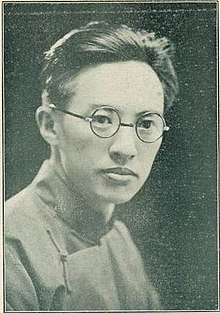Lü Yanzhi

Lü Yanzhi (Chinese: 呂彥直; pinyin: Lǚ Yànzhí; Wade–Giles: Lü Yen-chih; 1894–1929) was a Chinese architect. He won the competitions to design both the Sun Yat-sen Mausoleum in Nanjing and the Sun Yat-sen Memorial Hall in Guangzhou.[1] Lü died the year that the memorial hall began construction in 1929; it was eventually completed in 1931.
Background
Lü spent part of his childhood in Paris. He earned a degree in architecture from Cornell University, in the United States, in 1918 and then worked for Murphy & Dana until 1921,[1][2] when he went into independent practice in Shanghai.[3] Among projects he worked on with the firm are Ginling College in Nanjing and Yenching University in Beijing.[1]
Career
Lü's firm, whose name translates as "C. Lü Architect", was the first Chinese-owned architectural firm. In 1924, with Fan Wenzhou, he co-founded the first Chinese architectural association.[4] Considered one of the most gifted Chinese architects of his generation,[2] Lü won two prestigious national design competitions, for the Sun Yat-sen Mausoleum in September 1925,[3] and for the Sun Yat-sen Memorial Hall the following year. He died of cancer in 1929 and the Memorial Hall commission was completed by Li Jinpei.[1][5]
In keeping with the competition guidelines but also with the historicising impulse exemplified by Murphy & Dana's collegiate buildings, Lü's designs for both major commissions adapt traditional Chinese design features to modern uses.[2][6] His writings describe this as a means of asserting Chinese nationhood against foreign imperialism.[7] Liang Sicheng later criticised him for using only superficial aspects of Chinese architecture, which he wrote led to "a series of mistakes in proportions" in the hall in the mausoleum.[8] Other early historians of 20th-century Chinese architecture have also represented him as merely a draftsman, due in part to Henry Murphy describing him as such after he won the contest to design the mausoleum.[9]
References
- 1 2 3 4 Peter G. Rowe; Seng Kuan (2004). Architectural Encounters with Essence and Form in Modern China. Cambridge, Massachusetts / London: MIT. p. 221.
- 1 2 3 Rowe and Kuan, p. 69.
- 1 2 Jianfei Zhu (2013). Architecture of Modern China: A Historical Critique. Hoboken, New Jersey: Taylor and Francis. p. 54. ISBN 9781134720392.
- ↑ David Strand; Sherman Cochran; Wenxin Ye (2007). Cities In Motion: Interior, Coast, and Diaspora in Transnational China. China Research Monographs. 62. Berkeley: Institute of East Asian Studies, University of California: Center for Chinese Studies. p. 148. ISBN 9781557290892.
- ↑ Rowe and Kuan, pp. 69, 72.
- ↑ Zhu, pp. 68–70.
- ↑ Zhu, p. 53.
- ↑ Rowe and Kuan, pp. 84–85.
- ↑ Strand, Cochran and Ye, pp. 147–48.
Further reading
- Nancy Shatzman Steinhardt; Jeffrey W Cody; Tony Atkin, eds. (2011). Chinese Architecture and the Beaux-Arts. Spatial Habitus: Making and Meaning in Asia's Architecture. Honolulu: University of Hawaii. ISBN 978-0-8248-3456-2.